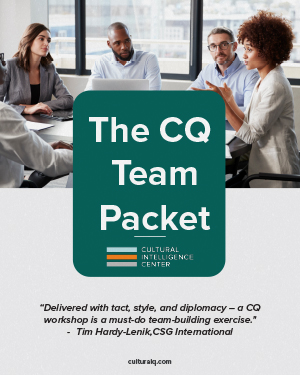One time I was speaking at a symposium in Prague to a group of emerging leaders from Eastern Europe. After a couple days at the conference, my U.S. colleague based in Czech said to me, “Okay Dave. Tell me who you think the strongest leaders are in this group.”
Without missing a beat I said, “Oh that’s easy, it’s Vaclav and Branka. You can just tell by watching them.” “I knew you’d say that,” he replied. “And they’d probably be great leaders back in the U.S. But the very thing that would help them succeed as leaders there–their charisma, enthusiasm, and intuitive style, will be the very things that are stumbling blocks for them here.” Then he proceeded to point out to me which individuals in the group did have the most influence. I couldn’t believe it. I never would have picked them out. But sure enough, a couple years later, they were the organization’s strongest leaders in the region.
Many leadership and management books give us the idea that leadership is a universal skill set that works the same anywhere. It sounds promising, but it just doesn’t jive with the realities of leading in our globalized world.
Biased Followers
All of us have implicit biases and assumptions about what makes a good leader. Many of these stem from our cultural backgrounds. And as with any cultural bias, often times we’re not even aware of leadership assumptions.
For example, what if you interview someone for a leadership position and they aren’t tall? Most of us would say that’s irrelevant. The average U.S. male is 5’ 9” and only 14% are 6’ or taller. But 58% of U.S. CEO’s are 6’ or taller. Apparently, if you want to be a CEO in the U.S., it sure helps if you’re tall.
In China, people expect their leaders to have a benevolent relationship with those they manage somewhat akin to what we might expect among parents and children. However, leading with that kind of style in many European contexts would be deemed patronizing and off-putting. And many African employees expect their leaders to display chief-like behaviors in how they manage the company.
The truth is, who’s a “leader” has as much to do with the expectations and stereotypes of followers as it does the leader’s behavior. Researchers have found some universally desired leadership traits among followers everywhere, such as competence, trustworthiness, and decisiveness. But there are many other characteristics that vary significantly from one culture to the next.
Lead with Cultural Intelligence
None of this sounds too promising for a world that’s getting flatter and smaller. Most of us have to manage people from lots of different cultural backgrounds. But there are some ways to do so effectively.
1. Get rid of the one-size fits all leadership mantras
Talking about “irrefutable laws of leadership” makes for nice seminar material but it doesn’t work out so great when working globally. For example, using an “empowering style of leadership” is usually lauded as an essential approach for any leader. And it’s certainly a style that I prefer personally.
But I work with many individuals in high power distance cultures for whom it’s very disorienting to feel like their manager isn’t being directive with them about what needs to be done. On the other hand, a leader who uses a very prescriptive and directive approach with someone who sees “empowerment” as a key to being effective is going to be tuned out quickly.
2. Adapt to various situations and followers
We need to look at various situations and followers and adjust our leadership style accordingly. Increasingly we have people from various cultures working on the same team so we have to figure out how to do this in a way that doesn’t become discriminatory or unrealistic. This is where cultural intelligence comes in—the capability to adapt to various cultures in order to motivate people to accomplish a shared set of objectives.
Leading with cultural intelligence doesn’t mean being a chameleon to every individual and situation encountered. But it does mean knowing when an empowering style is most necessary as compared to a more directive one. The same applies to when we should address conflict head-on, and when we need to be more indirect (yes—both are appropriate!). And as we grow in the four capabilities of cultural intelligence (drive, knowledge, strategy, and action), we increasingly know how to adapt on-the-fly to various situations that arise.
3. Be yourself
In having assessed the cultural intelligence of nearly 25,000 individuals around the world, my colleagues and I have found another interesting variable for effective global leadership. While culturally intelligent leaders know how to adapt to various situations and followers, they also demonstrate a level of comfort in their own skin. Whether it’s the company brand or one’s personal identity, the challenge is how to adapt enough to accomplish our objectives in a way that’s both respectful and effective but not go so far that we’re no longer true to ourselves.
Research demonstrates that it is possible to be an effective leader globally. But it’s going to take more than just that gut-level, sixth sense that is often talked about. It requires discipline and hard work to become more adaptable in how we inspire and lead people in an increasingly diverse world. And with that hard work, slowly but surely, you can be a global leader.
